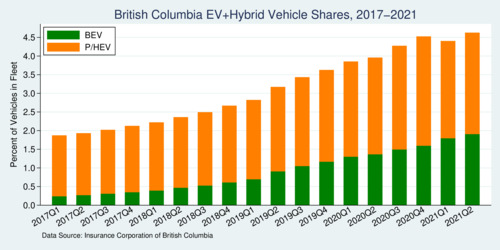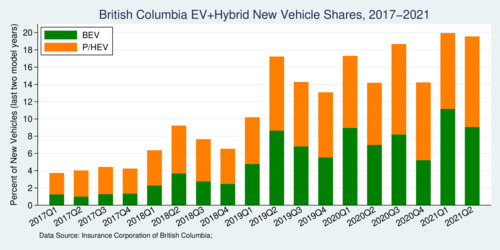British Columbians take pride in being environmental leaders. One way this is manifesting itself is the relative speed with which British Columbians are embracing electric vehicles (EVs). While some countries such as Norway have already reached the point where more than half of all new cars are electric, B.C. is making strides ahead of other jurisdictions in Canada as well as other jurisdictions in North America (ICCT 2020).
‘British Columbia is one of the leaders in North America for electric vehicle adoption.’
Using data from ICBC that is part of my research project on EV adoption and electric vehicle charging station (EVCS) adoption, there is a clear trend that is emerging. The first chart below shows the share of electric (battery and plug-in hybrid) vehicles [green bars] along with the share of mild hybrid vehicles [orange bars]. Mild hybrids were the first wave of going green, promising better fuel economy but not yet the ability to plug in to the electric grid. The overall share of both types combined has reached 4.5% by the end of 2020. Counted are all passenger vehicles with owners residing and insured in British Columbia. By the end of 2020, nearly 39,000 electric vehicles were driving on B.C. roads, plus another 71,000 hybrid vehicles. The share of EVs in the total fleet reached 1.6%.

click on image for high-resolution PDF version
The above shares look small, but vehicle fleets turn over slowly. The average car lasts about 12 years, and thus we see about 8%–9% of vehicles turning over every year. Much then depends on the share of EV among new vehicles. The next diagram shows the market share of EVs and hybrid vehicles for vehicles appearing newly-registered on B.C.'s roads and having been built in the current or previous year (model years). Here the picture looks much rosier. The year 2020 saw the share of EVs rise, topping 9% in 2020Q1 but (perhaps because of the pandemic but also because of seasonal factors) falling to 5.2%.

click on image for high-resolution PDF version
According to Statistics Canada, all across Canada roughly two thirds of new zero-emission vehicles (ZEVs) are battery-electric vehicles (BEVs) while about one-third are plug-in hybrid electric vehicles (PHEVs).
The above picture masks big spatial differences. Driving electric is much easier if you live in urban areas where public charging stations are more readily available and where infrastructure for EVCS is also making larger inroads. The next chart shows the share of EVs in major urban centers in British Columbia. Included are only cities where more than 10,000 vehicles of all types are registered.
Unsurprisingly, the greatest concentrations of electric vehicles can be found in Metro Vancouver and the Capital Region District on Vancouver Island. Jurisdictions with more than 2% EV ownership in Metro Vancouver include West Vancouver, North Vancouver, Port Moody, Coquitlam, Richmond, Vancouver, Port Coquitlam, and White Rock. West Vancouver with over 4% EV adoption stands out perhaps because of its particularly affluent population. On Vancouver Island, Sidney (North Saanich) and Victoria have the highest rate of EV adoption.
Again, overall EV adoption shares say little about where trends are pointing in the next few years. Looking at only the 2020 and 2021 model years of new vehicles in municipalities where at least 1,000 new vehicles of all types were registered, several municipalities have EV adoption rates in excess of 10%. Among them are West Vancouver, Victoria, North Vancouver, Delta, Vancouver, Port Coquitlam, Langley Township, Coquitlam, and Port Moody. A number of other cities are not far behind, including Burnaby and Surrey. Moving into less-densely populated areas in B.C., EV adoption rates are significantly lower.
What are the key insights from the above statistics? First, EV adoption is growing fastest in urban areas. It is growing slower in rural areas because people tend to drive longer distances and thus worry more about EV range and charging station networks. Second, there is a wealth effect in early adoption. The earliest generations of EVs were comparatively expensive due to the cost of batteries. However, electric vehicles are approaching price parity and the EV tipping point is firmly in sight. Third, driving electric is already much cheaper than driving with gasoline for each kilometer driven. Even at today's gas prices, driving electric in B.C. is about four times cheaper (see my blog How much money could be saved by driving electric in Canada?).
‘EV charging emerges as the most significant hurdle to EV adoption.’
So what is still holding back EV adoption in B.C. today? The first big problem was choice. There were few EV models available until now, and they tended to be either expensive luxury cars or compact cars with limited range to keep the price down. This left EVs the domain of affluent households or niche applications. This is massively changing as car makers offer more and better EV choices, and several are already firmly committed to phasing out gasoline engines. The second problem is charging. If you live in a single-detached home with on-street parking only, charging at home is impractical or impossible. If you live in a strata complex, you are at the mercy of the strata council or finding a 3/4-majority at an annual general meeting of the strata. If you live in a rental building, your landlord may not be interested in retrofitting charging stations. There are several market failures due to these agency problems, and thus overcoming obstacles to charging may well be the greatest challenge to rapid electrification of mobility in British Columbia. Fortunately, there are both federal and provincial programs for incentivizing EVCS installation. BC Hydro manages the province's Clean BC "Go Electric" EV charger rebate program, and Natural Resources Canada has a Zero Emission Vehicle Infrastructure Program. Eligible households, businesses, and stratas can apply to receive rebates.
Further readings and information sources:
- Statistics Canada: Zero-emission vehicles in Canada, third quarter of 2020,
- International Energy Agency: Global EV Outlook 2020, Jue 2020.
- Netherlands Enterprise Agency: Quickscan of EV Market in British Columbia and Vancouver Opportunities and challenges, May 2020
- Roshanak Azarafshara and Wessel N.Vermeulen: Electric vehicle incentive policies in Canadian provinces, Energy Economics 91, September 2020.
Updated on Friday, September 3, 2021